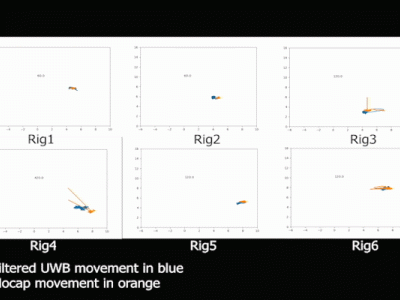indoor Localization
Due to the rapid mobility and superior obstacle surmounting capabilities, quadruped robots are increasingly employed in industrial inspections. Quadruped robots usually utilize laser simultaneous localization and mapping (SLAM) for autonomous navigation. However, SLAM is susceptible to inaccuracies under the rapid movement and rotation of quadruped robots.
- Categories:
 27 Views
27 Views
The Internet of Things (IoT) is the nova emergence of connecting devices, people, and objects over the internet as sensors and actuators for a targeted application. Among popular IoT applications, location based IoT services are curtailed. Where the geographical location of a moving object will be estimated based on signal strength values using algorithms. To estimate the locations using algorithms distance measurement such as Received Signal Strength Indicator (RSSI) is required.
- Categories:
 141 Views
141 ViewsThe Bluetooth 5.1 Core Specification brought Angle of Arrival (AoA) based Indoor Localization to the Bluetooth Standard. This dataset is the result of one of the first comprehensive studies of static Bluetooth AoA-based Indoor Localization in a real-world testbed using commercial off-the-shelf Bluetooth chipsets.
The positioning experiments were carried out on a 100 m² test area using four stationary Bluetooth sensor devices each equipped with eight antennas. With this setup, a median localization accuracy of up to 18 cm was achieved.
- Categories:
 1024 Views
1024 ViewsRSSI measurements collected by four anchors while receiving messages from a single mobile node transmitting advertisement and extended advertisement messages in all BLE channels (both primary and secondary advertisement channels). Tests conducted in 10x10 m office area (no large obstacles), with 4 anchors located in the corners of the area.
Cite https://ieeexplore.ieee.org/document/9661373 when using this dataset in your work.
- Categories:
 727 Views
727 ViewsThis is a CSI dataset towards 5G NR high-precision positioning,
which is fine-grained, general-purpose and 3GPP R18 standards complied.
The corresponding paper is published here (https://doi.org/10.1109/jsac.2022.3157397).
5G NR is normally considered to as a new paradigm change in integrated sensing and communication (ISAC).
- Categories:
 5442 Views
5442 Views
Dataset used for "A Machine Learning Approach for Wi-Fi RTT Ranging" paper (ION ITM 2019). The dataset includes almost 30,000 Wi-Fi RTT (FTM) raw channel measurements from real-life client and access points, from an office environment. This data can be used for Time of Arrival (ToA), ranging, positioning, navigation and other types of research in Wi-Fi indoor location. The zip file includes a README file, a CSV file with the dataset and several Matlab functions to help the user plot the data and demonstrate how to estimate the range.
- Categories:
 2769 Views
2769 ViewsImproving performance and safety conditions on industrial sites remains a key element of the company's strategy. The major challenges require, the ability to dynamically locate people and goods on the site. Security and regulation of access to areas with different characteristics (types of tasks, level of risk or confidentiality...) are often ensured by doors or badge barriers. These means have several weaknesses when faced with inappropriate movements of people, but also an inappropriate use of objects or tools.
- Categories:
 200 Views
200 Views
Visible Light Positioning is an indoor localization technology that uses wireless transmission of visible light signals to obtain a location estimate of a mobile receiver.
This dataset can be used to validate supervised machine learning approaches in the context of Received Signal Strength Based Visible Light Positioning.
The set is acquired in an experimental setup that consists of 4 LED transmitter beacons and a photodiode as receiving element that can move in 2D.
- Categories:
 914 Views
914 Views
This RSSI Dataset is a comprehensive set of Received Signal Strength Indicator (RSSI) readings gathered from three different types of scenarios. Three wireless technologies were used which consisted of:
- Zigbee (IEEE 802.15.4),
- Bluetooth Low Energy (BLE), and
- WiFi (IEEE 802.11n 2.4GHz band).
The scenarios took place in three rooms with different sizes and inteference levels. For the experimentation, the equipment utilized consisted of Raspberry Pi 3 Model Bs, Gimbal Series 10 Beacons, and Series 2 Xbees with Arduino Uno microcontrollers.
- Categories:
 4773 Views
4773 Views





